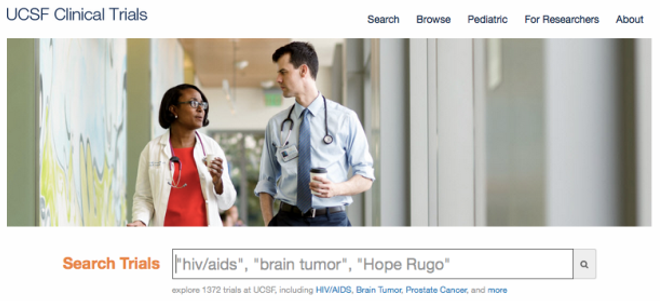By Leslie Yuan and Anirvan Chatterjee. The research technology team at UCSF’s Clinical and Translational Science Institute (CTSI) recently launched a website for UCSF’s clinical studies. The goal was an easy-to-use site where people could search through all clinical trials at UCSF, identify studies of interest, and easily contact the study teams to learn more and/or participate.
In addition, we had a vision to design and architect this website so other UC locations (and other institutions) could re-use the software code and techniques for their own campuses. Since we launched, our team has been awarded a two-year National Institutes of Health grant to work with the other four UC Health campuses (UCLA, UCSD, UCD, and UCI) to create a UC-wide clinical trial finder, as well as to spin up campus-specific sites if desired. As we worked, five general approaches bubbled up. We thought they were worth sharing with folks who are working on institutional websites with less-than-pristine data sources.
- Embrace dirty/incomplete data
UC campuses that run clinical trials store their information in very different systems and use disparate data fields. Instead of waiting for every campus to provide perfect interoperable data, we decided to use a pragmatic approach and combine public open data from clinicaltrials.gov with publicly sharable data available through internal systems.
Our solution is just good enough to work, and we employ a wide variety of strategies to clean up the data we receive. For example, there are least a dozen different ways to identify HIV/AIDS clinical trials (e.g., “HIV,” “Human Immunodeficiency Virus,” “HIV Infection”). Instead of forcing every researcher to standardize condition names, it’s easier for us to come up with a list of all terms, and with the software, catch most of the variations to use the data effectively on this site.
- Pay attention to Google
We know that many users of UCSF’s public-facing websites get to us via search engines like Google. That’s why we architected our website to expose hundreds of condition-specific landing pages that include the condition name right in the web address, e.g., “clinicaltrials.ucsf.edu/psoriasis.” We used other Google-friendly tactics to ensure that the right studies show up high on a list of search results. For the technologists reading this, that includes customized page titles, meta description tags designed for search users, and machine-readable Schema.org metadata (e.g., locations and breadcrumbs).
We’re already receiving 43% of our traffic from search engines, and expect that proportion to keep growing.
- Obsess about analytics
You can’t evaluate what you can’t measure. From the beginning, we selected a number of key metrics to measure and we designed the site to capture data to help us evaluate the volume of folks who come to the site, how people use the site, where they click, how long they stay, and what they do before clicking the “I’m interested” button. Within two months of launch, we celebrated when our new site got double the amount of traffic as the system it replaced.
- Build alliances
We created partnerships with other UCSF groups that have lists of clinical trials on their own websites, including the Cancer Center, the Memory and Aging Center, BreastCancerTrials.org, and the UCSF Medical Center, which managed the legacy site that ours would replace.
We assured partners that our site complemented theirs, and because it could help increase traffic to their sites, it would hopefully increase the number of volunteers for their trials. Our goal was to provide a comprehensive list of trials at UCSF and provide an obvious and additional way for the public to contact the trial teams. We hoped to help raise the visibility and web traffic for studies that had little web presence—and not to replace any of the specialized work each partner had done for their own constituents.
On the other hand, since we actually were replacing the Medical Center’s years-old clinical trials site, we focused on their needs at a more technical level, making sure that any old website addresses weren’t broken and would lead people to the new site. The primary focus for the Medical Center is patient care, not research, so they were comfortable transitioning the research-focused clinical trials search site to our team.
- Make life easier for others
We’ve benefited heavily from the work of others, both at UCSF and externally, and now have started sharing and connecting back with our communities. For example:
- We’re working with UCSF’s Participant Recruitment Program to support in-clinic clinical trial recruitment kiosks.
- We talk to clinical research coordinators about the need to keep study information updated, both to support our own work, as well as to improve data quality for everyone.
- We reach out to the teams whose studies have had the most web traffic and the most clicks on the “I’m interested” button to share what we’re seeing and work with them to see if this method of contact works and/or can be improved.
- We’re talking to the UCSF Cancer Center about sharing all of our data to support their work and websites.
- We share technical methods with partners at other universities that are working on similar projects.
 Leslie Yuan is chief information officer and director of research technology for the UCSF Clinical and Translational Science Institute.
Leslie Yuan is chief information officer and director of research technology for the UCSF Clinical and Translational Science Institute.
 Anirvan Chatterjee is director of data strategy for the UCSF Clinical and Translational Science Institute.
Anirvan Chatterjee is director of data strategy for the UCSF Clinical and Translational Science Institute.

